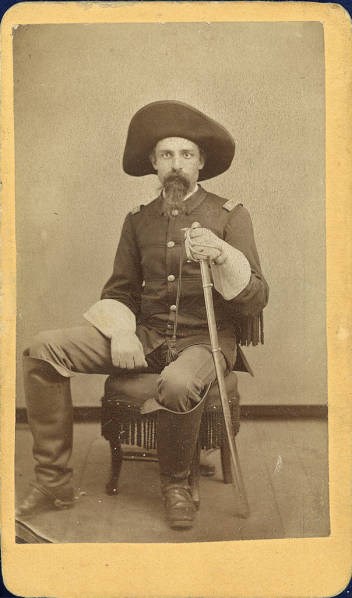
NPS Photo, Little Bighorn Battlefield National Monument Lieutenant Edward S. Godfrey was tasked to round up all the Indians' ponies. "While the roundup was progressing I observed a group of dismounted Indians escaping down the opposite side of the valley. Completing the roundup, and starting them toward the village, I turned the herd over to Lieutenant Edward Law who had come with the second platoon of the troop and told him take them to the village, saying that I would take my platoon and go in pursuit of the group I had seen escaping down the valley. Crossing the stream and striking the trail, I followed it till it came to a wooded draw where there was a large pony herd. Here I had found the group had mounted. Taking the trail which was well up on the hillside of the valley, and following it about a couple of miles, I discovered a lone tipi, and soon after, two Indians circling their ponies. A high promontory and ridge projected into the valley and shut off the view of the valley below the lone tipi. I knew the circling of the warriors meant an alarm and rally, but I wanted to see what was in the valley below. Just then Sergeant [Levi] Connor, who had been a captain of the Ohio volunteers, and [First] Sergeant Hughes [Higgins], who had served in the 4th U.S. Cavalry in that country before the Civil War, came to me and warned me of the danger of going ahead. I ordered them to halt the platoon and wait till I could go to the ridge to see what was beyond. Arriving at and peering over the ridge, I was amazed to find that as far as I could see down the well wooded, tortuous valley there were tipis. Not only could I see tipis, but mounted warriors scurrying in our direction. I hurried back to the platoon and returned at the trot till attacked by the hostiles, when I halted, opened fire, drove the hostiles to cover, and then deployed the platoon as skirmishers. The hillsides were cut by rather deep ravines and I planned to retreat from ridge to ridge. Under the cavalry tactics of 1841, the retreat of skirmishers was by the odd and even numbers, alternating in lines to the rear. I instructed the line in retreat to halt on the next ridge and cover the retreat of the advance line. This was successful for the first and second ridge, but at the third I found the men and apparently forgotten their numbers and there was some confusion, so I divided the skirmishers into two groups, each under a sergeant, and thereafter had no trouble. Finally, the hostiles left and we soon came to the pony herd where the group we had started to pursue had mounted. I had not a single casualty. During this retreat we heard heavy firing on the opposite side of the valley, but being well up on the side hills we could not see through the trees what was going on. There was a short lull when the firing again became heavy and continued till long after we reached the village, in fact, nearly all day."
|
Last updated: September 16, 2019
